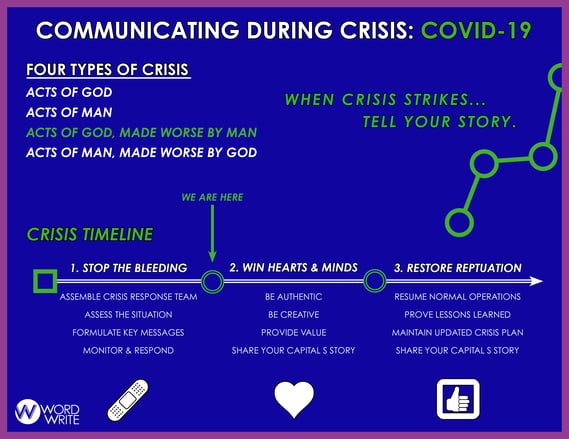What businesses should be doing during the first phase of the COVID-19 crisis


In just a matter of days, COVID-19 has taken a toll on nearly all businesses. You’ve probably seen a variety of emails and social media posts giving company updates on how they are handling the situation. Perhaps you’ve even sent some yourself. That’s because during a time of crisis, communication is key.
In fact, on March 3, before coronavirus made its way to Pennsylvania, we discussed the importance of getting the facts right in this blog post. And in just two weeks, we’ve seen how critical this is. Just as we rely on the government, health officials and the media to share accurate updates that are easy to understand, your employees and stakeholders are expecting the same due diligence from your organization. Most companies have already shared information with consumers and employees, but this is just the beginning and organizations need to keep preparing.
Crises require three response phases:
- Stop the bleeding,
- Win hearts and minds, and
- Restore reputation.
The past few days, every organization affected negatively by this crisis has been working to stop the bleeding. And when it comes to this response, there is a process companies can follow to get organized and ensure they are communicating as effectively as possible. If you’re having difficulty, ask yourself:
Have you identified your Crisis Response Team (CRT)?
At a time like this, there should be a group of key people who make the important decisions. This crisis response team (CRT) or task force should consist of senior management, including the president/CEO and directors from the communications/marketing, operations, human resources and legal departments. These five or so individuals should be the first to meet to assess the situation, create a plan and implement it as soon as possible. With COVID-19 changing so quickly, many CRTs are meeting daily, or even two or three times daily.
Do your employees know where to find and share information?
Communication must begin within the organization. To get the most up-to-date information, all employees must know where to share information to ensure it gets to the CRT. We call this “arranging information flow.” Make sure each employee in your company know where to share information. This will help keep the CRT informed and poised in the best position to respond.
Have you been sharing thoughtful key messages?
Your authentic story is never more important than in a crisis.
What do we mean by that?
Using COVID-19 as an example, organizations that come off as self-serving could hurt their reputations. Getting through this crisis is a community effort. That’s why the CDC is encouraging social distancing.
It might seem like business as usual has stopped, but marketing expert Neil Patel says now is the time to seize opportunity. In his latest blog post, he discusses how online organic traffic for many industries has fallen dramatically except for the news media, financial and some e-commerce sites selling essential goods. But is now the time to keep marketing?
Yes and no.
Yes, keep sharing the important messages your stakeholders and target audience need to know.
No, do not approach this as a sales opportunity and market as such.
Be authentic. Provide value. Help your community! We’ve seen a ton of great examples. Cybersecurity companies are sharing tips to keep computers secure since so many employees are working from home. Eight Oaks Farm Distillery in Pennsylvania is using alcohol to make hand sanitizer. The YMCA of Greater Pittsburgh started the initiative YWithYou to provide virtual tools and resources to keep people healthy in their homes.
In other words, think about your target audiences and how you can best help them. What opportunities can your business provide to others who need help during this crisis?
We’ve also seen a lot of organizations relying on social media to share updates. Don’t forget about your website. Not everyone is on social media, so it’s important to make important updates easily available for everyone.
Storytelling is incredibly important, especially in times of crisis. Key messages should be simple, easy to find and authentic. Read more about our view on Capital S storytelling in a crisis.
Have you been monitoring and preparing for the future?
As we’ve observed with COVID-19, health and government officials are putting out constant updates. It’s especially important to stay current with what the experts are sharing. Unfortunately, businesses are going to be impacted. Leverage this time, when your usual flow of work might be slower, to plan for future crisis situations such as:
- Shutting down operations for a long period of time
- Employee(s) becoming infected with COVID-19
- Cybersecurity attacks as employees work remotely
- Laying off employees
- Closing locations or ending programs
These scenarios are difficult to fathom, but if you think through the worst-case scenarios now, you’ll be much more prepared and probably better able to reduce the damage if they come to fruition.
As we move away from the “stop the bleeding” phase, the next response phase is to win hearts and minds. We’ve already seen some companies implement creative ways to stay in touch with their audience through live streaming and other digital accommodations. This is the time to be creative.
